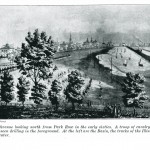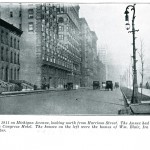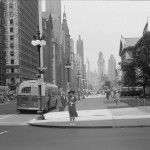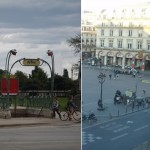For many tourists, a visit to Chicago is a visit to Michigan Avenue. Some never go anywhere else. After all, Michigan Avenue has everything you could ever need: hotels, restaurants, shopping, art, music, architecture, museums and parks.
By design, the downtown streetscape is reminiscent of our sister city Paris. One of the entrances to the Van Buren METRA station is even designed to fool you into thinking you are entering the Paris Metro. The METRA will take you to Notre Dame du Lac (the university), although not to Notre Dame de Paris (the cathedral).
Michigan Avenue is not named after the state. Rather it, like the State of Michigan, is named after Lake Michigan. According to the Library of Michigan, the name comes from a Native American word meaning “Great Water.”
As explained in my Grant Park posts, currently Michigan Avenue is nearly half a mile inland, but in 1836 Michigan Avenue ran in a north-south direction along the lakefront. Chicago has streets named after the other Great Lakes: Erie, Ontario, Huron and Superior, but they run east-west. It is fitting that Michigan Avenue is different, as Lake Michigan clearly runs north-south and is the only Great Lake touching Chicago.
When the avenue was annexed to the young city of Chicago in 1839, it extended a mile south of Randolph Street. It has since been extended north (the subject of my next post) to join Lakeshore Drive at 950 North. To the south it runs to the city limits and well beyond as a mostly residential street.
Until the Great Fire of 1871, the original section of Michigan Avenue between Randolph and what is now Roosevelt was a premier residential district. After the fire, the wealthy built their new mansions a mile or so south on Michigan and Prairie avenues near 20th Street.
The downtown portion became a choice commercial and cultural district hosting the likes of Montgomery Ward, the public library, Encyclopedia Britannica, Symphony Center and the Auditorium Building. The 1909 Plan of Chicago further cemented Michigan Avenue’s role as a grand Parisian-style street hosting a number of distinguished institutions. Today this section is a Chicago Landmark designated as the Historic Michigan Boulevard District.
Other parts, such as the Motor Row District near 20th, are also landmarked. For more information on this history-filled street, take a look at our resources on Michigan Avenue.








Add a comment to: Michigan Avenue: A Touch of Paris in Chicago